Exploring the Intersection of Spirituality and Artistic Freedom

Understanding Spirituality in the Creative Context
Spirituality often refers to the search for meaning or connection to something greater than ourselves. In the realm of creativity, this can manifest as a source of inspiration or motivation. Artists may find that their spiritual beliefs shape their art, providing depth and meaning that resonates with audiences.
Art is the most beautiful of all lies.
For many, spirituality is not confined to religious practices but encompasses a broader understanding of existence. This perspective allows artists to explore diverse themes such as love, nature, and the human experience. Ultimately, spirituality can serve as a guiding force that enhances artistic expression.
Take, for instance, Vincent van Gogh, whose deep connection to nature and spirituality influenced his iconic works. His art reflects not only what he saw but also what he felt, demonstrating how spirituality can enhance artistic output and provide a unique narrative.
Artistic Freedom: A Canvas for Expression
Artistic freedom represents the liberty to express one's thoughts, feelings, and beliefs without restraint. This freedom is crucial for artists, allowing them to explore complex ideas and emotions without censorship. The intersection of art and freedom fosters a space where creativity can thrive and evolve.

When artists embrace this freedom, they often challenge societal norms and expectations, leading to innovative and thought-provoking work. This can range from visual arts to literature, where the expression of personal truths becomes a powerful tool for change. The freedom to create thus becomes an act of rebellion and self-discovery.
Spirituality Fuels Creative Inspiration
Artists often draw on their spiritual beliefs as a source of inspiration, adding depth and meaning to their work.
Consider the works of artists like Frida Kahlo, who used her art to express her identity and experiences. Her exploration of personal pain, cultural identity, and gender issues exemplifies how artistic freedom allows for profound exploration and connection with audiences.
The Synergy Between Spirituality and Artistic Freedom
When spirituality meets artistic freedom, the resulting synergy can lead to powerful and transformative art. Artists often find that their spiritual beliefs inspire them to push boundaries and express their deepest truths. This interplay can create a rich tapestry of creativity that resonates on multiple levels.
The artist is nothing without the gift, but the gift is nothing without work.
For example, the music of Bob Marley blends spiritual themes with a call for freedom and social justice. His songs are not just melodies but manifestos that speak to both the soul and society. This fusion of spirituality and artistic expression can pave the way for deeper understanding and connection.
Ultimately, this synergy encourages artists to look within, drawing from their spiritual journeys to fuel their creativity. As they navigate their personal beliefs and artistic aspirations, they contribute to a larger dialogue about the human experience.
Challenges at the Intersection of Art and Spirituality
Despite the beauty of merging spirituality and artistic freedom, challenges often arise. Artists may grapple with societal expectations, commercial pressures, or self-doubt that can stifle their creativity. Navigating these waters requires resilience and a commitment to personal truth.
Moreover, the interpretation of spiritual themes can vary widely among audiences, leading to miscommunication or backlash. Some may misunderstand an artist's intent or feel uncomfortable with themes that challenge their beliefs. This can create tension, but it also opens up opportunities for dialogue and growth.
Artistic Freedom Enables Authenticity
The freedom to express personal truths allows artists to challenge norms and create thought-provoking art.
Artists like Ai Weiwei have faced significant challenges when addressing political and spiritual themes. His work often invites controversy, but it also sparks critical conversations about freedom, identity, and societal values, showcasing the power of art to provoke thought and challenge the status quo.
Finding Balance: The Artist's Journey
For many artists, finding balance between spirituality and artistic freedom is an ongoing journey. It involves introspection, exploration, and sometimes a leap of faith. Embracing this balance can lead to more authentic and impactful work that resonates with both the creator and the audience.
This journey may require artists to confront their fears and insecurities, allowing them to express their authentic selves. By staying true to their spiritual beliefs while exercising artistic freedom, they can create work that is both personal and universally relatable.
Take the poet Rumi, whose verses blend spirituality and a profound exploration of love and existence. His work exemplifies how finding balance allows artists to communicate complex emotions and ideas, creating a lasting impact on readers across generations.
The Role of Community in Nurturing Creative Expression
Community plays a vital role in nurturing the intersection of spirituality and artistic freedom. When artists come together, they create a supportive environment that fosters creativity and exploration. This sense of belonging can empower individuals to express their unique perspectives and experiences through their art.
Artistic collectives and spiritual groups often provide platforms for collaboration and idea exchange. These spaces encourage artists to share their journeys, learn from one another, and push the boundaries of their creative expressions. The community acts as a catalyst for innovation and understanding.
Community Nurtures Creative Growth
Supportive artistic communities empower individuals to explore their creativity and share unique perspectives.
Consider the Harlem Renaissance, where an entire community of artists, writers, and musicians came together to celebrate their cultural identity. This movement not only fostered artistic freedom but also infused spiritual and social themes into their work, leaving a lasting legacy that continues to inspire.
Embracing the Journey: Art as Spiritual Practice
For many artists, the creative process itself becomes a spiritual practice. Engaging in art allows them to connect with their inner selves and explore their beliefs and feelings. This journey can lead to personal growth and a deeper understanding of one's purpose.
Art as a spiritual practice can also serve as a form of meditation or reflection, enabling artists to process their experiences and emotions. This mindful approach often results in work that is rich in meaning and authenticity, resonating with those who encounter it.

An example is the practice of mandala art, where the act of creating intricate patterns becomes a meditative experience. This form of art encourages mindfulness and self-exploration, illustrating how the act of creation can intertwine spirituality and artistic expression in a beautiful, harmonious way.